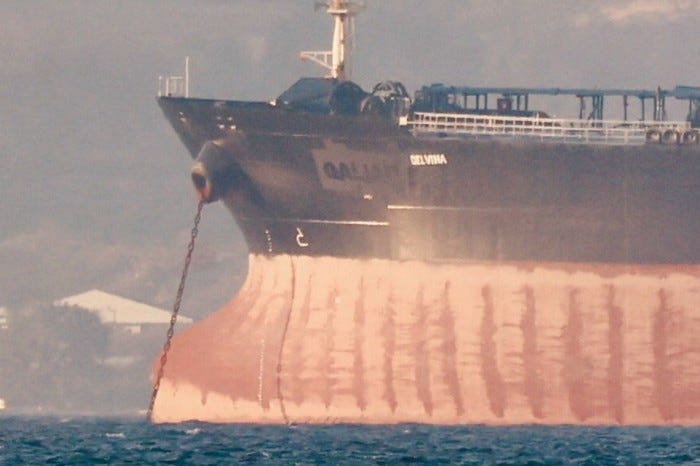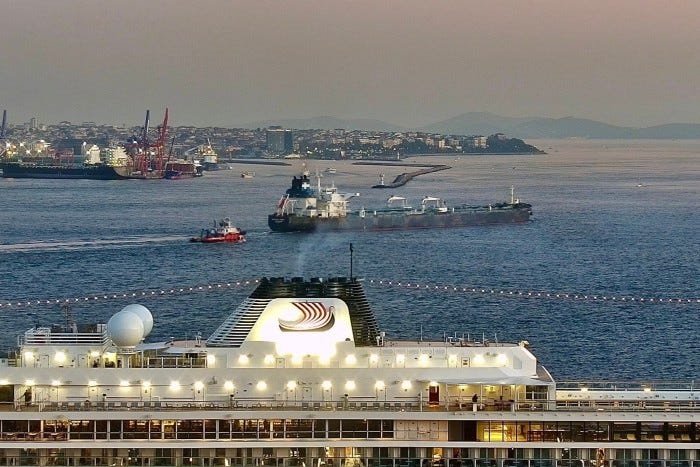How Russia's shadow fleet sells oil 🛢️🚢
& how does sanctions evasion fund Russia's war in Ukraine?
Today’s newsletter is about shadow tankers.
These are tanker ships operating outside the legal global shipping network to move oil in secretive or illicit ways.
Over the last few years, Russia has built up a shadow fleet of hundreds of oil tankers that ship millions of barrels of oil daily.
The goal: avoiding American & European sanctions on their oil exports.

In February 2022, Russia invaded Ukraine.
In response, G7 leaders banned Western shipping companies from transporting Russian oil across the ocean - unless the oil was sold at a maximum price of $60 per barrel.
Oil & gas exports make up:
~60% of all Russian exports, and
~40% of Russian government revenue.
The price of a barrel of oil has ranged from $65-$85 per barrel since 2022, so that price cap would severely reduce Russian oil revenue.
As a result, the Russian government decided to find new ways to sell oil to continue funding the war effort.
According to the Brookings Institution think tank:
“A focal point of the shadow fleet strategy is to obscure the ownership of the fleets’ tankers and to mask the origin of the Russian oil those ships carry.
To do this, Russia employs a host of deceptive maneuvers, such as repeated ship-to-ship transfers of liquid cargo, blending oil from multiple countries, spoofing ships’ location data, and automatic identification system blackouts.”
Shadow fleets pose two major problems:
They undermine the international sanctions system designed to punish rogue states like Russia, Venezuela & Iran.
They increase the risk of accidents at sea while reducing accountability for shadow fleet operators
With the shadow fleet, Moscow can move about 4 million barrels of oil per day, generating billions of dollars in revenue annually.

Most of the sanctioned Russian oil is being sold to China and India.
However, investigators have found that some of it is being sold to oil-rich countries like Saudi Arabia and the United Arab Emirates.
The Russian oil is discounted, so these countries can use cheap Russian oil domestically while selling more of their oil to Europe.

The story of who is operating these tankers and where they’re coming from is also worth exploring.
According to the Financial Times:
“the use of offshore corporate [ownership] structures has meant western officials have struggled to identify who owns the tankers, how they were acquired or who oversees their operations.”
These shadow tankers are typically older ships flying a so-called “flag of convenience.”
The ship could be flying the flag of a small country like the Marshall Islands… but in reality, it’s working on behalf of Russia.
According to the Kyiv School of Economics, 307 shadow tankers transported Russian crude oil between January 2023 and June 2024.
Of those 307 tankers, a core fleet of 45 ships consistently moves Russian oil.
Check out this map of accidents that have taken place involving Russian shadow tankers since 2022:
Thankfully, Western leaders are catching on to the shadow tanker game.
Over the past two years, the U.S., U.K., and E.U. have sanctioned ~270 accused shadow tankers.
Because of these sanctions, about 2/3 of the sanctioned ships have reportedly gone idle.
As Trump’s tariff policies drive global oil prices down, it will be interesting to see if Russia can keep its shadow fleet afloat.










I'm afraid that the Greek shipowners have a lot of explaining to do.